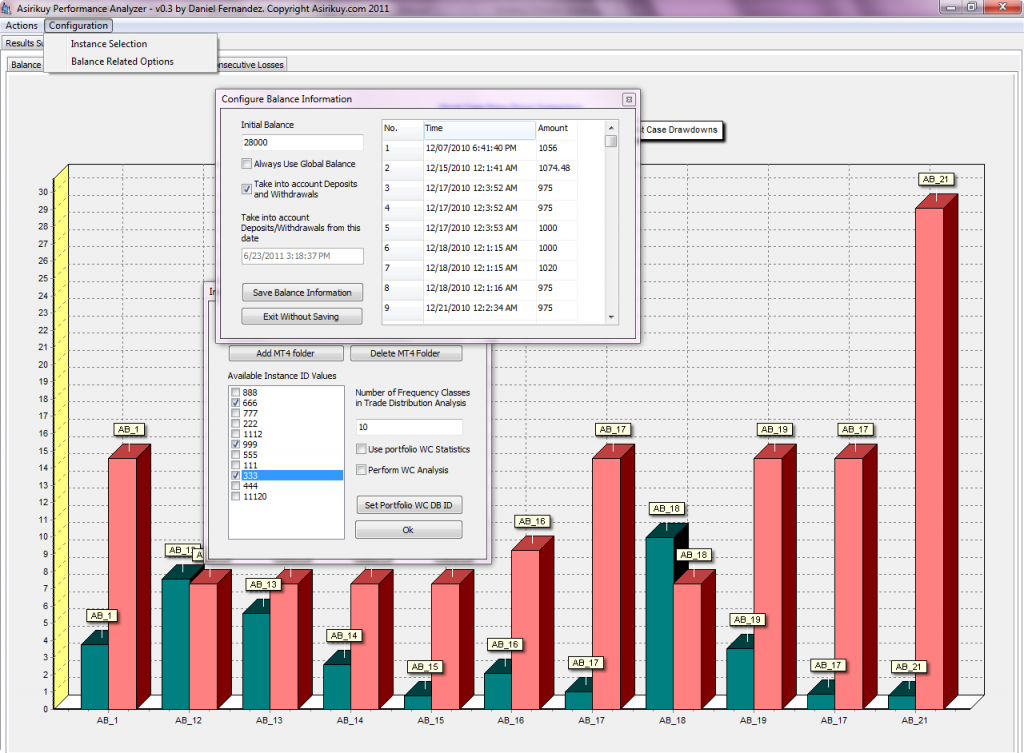A few months ago I coded the first two versions of what would become the Asirikuy Peformance Analyzer (APA) software which allows Asirikuy members to dynamically analyze the results of their live accounts and compare them with worst case scenarios obtained from our worst case database analysis tool. Through the past few weeks I have been working hard on the improvement of this tool in order to improve its capabilities and implement several suggestions made by Asirikuy members. On today’s post I will talk about the achievements I have made in this regard, the improvements implemented within the new version of the APA and what new features I am currently working on. You’ll see why the APA is becoming a very powerful took and get a glimpse at the huge potential this tool we have once we completely merge it with the ADA (Asirikuy Database Analyzer) we’re also currently working on.
The Asirikuy Peformance Analyzer was built with the idea to help us analyze our live trading results. Since the idea when live trading a portfolio is to continuously evaluate the outcomes of our strategies against previously defined worst case scenarios it therefore becomes fundamental to be able to quickly assess the particular state of a given trading strategy regarding its individual draw down, consecutive losses and other such important statistical characteristics. The Asirikuy Performance Analyzer – with the help of a saving EA which records account data into a database – enables a trader to get a thorough analysis of his or her portfolio in order to know draw down levels, equity graphs and other important information in a system-by-system basis.
–
–
Perhaps the most important feature of the APA – as mentioned above – is its ability to obtain worst case scenarios from a database which has these values saved. Such is the objective of the worst case database tool which was released many months ago but which will be replaced in the future by the Delphi ADA which will allow us to have even more powerful control over which worst case scenarios to use. Once we have full integration of the ADA and APA tools a user will be able to access the Asirikuy General System Database to obtain worst case information along with a much deeper list of intended statistics for a given portfolio. The APA will then perform a much more powerful statistical comparison than what is presently available, showing the user exactly how the system is behaving Vs its expected long term statistical results.
In order to move towards this goal this version of the performance analyzer has been greatly improved in order to make its interface much more user friendly, its DB capabilities more powerful and to fix several problems which had been reported by Asirikuy members. The interface of the APA has now been changed in order to make it “menu-based” so that the first screen previously shown has now been eliminated. Instead users will now be able to access both instance selection and balance option configuration through user-friendly menus which will allow them to select the instance IDs they want to analyze and the balance related options relevant to them. In addition the listbox mechanism to select instances has now been eliminated and replaces by a simple listbox filled with check boxes which easily enabled users to toggle between different Instance ID values.
In order to make analysis easier I have also implemented several changes that have made the tool much more user-friendly including a “System name” assignation possibility which enables the user to deal with System names instead of Instance ID values after they have been assigned. In this way a trader can now input all the relevant names for his/her systems and then simply hover over the instance ID values to get a little box showing the system name. In addition the graphs now display system names (if available) instead of instance ID values so a user can now get a much easier view of what is going on inside the account without needing to memorize or constantly refer to instance ID values.
From a functional perspective I have greatly increase the database capabilities of APA with all account settings (balance, instance worst cases, system names, etc) now kept internally within the DB created by this tool. Previously this information was kept within simple text files within each MT4 folder but this new database solution enables much more powerful “book-keeping” when compared to this previous text file solution. The APA now uses this database to save information and hopefully within the future the tables within this DB will be added to the Asirikuy General DB in order to allow all Asirikuy related system information to remain centralized.
As you can see great graphical and functional improvements have been made to the APA and hopefully the tool will continue to be improved as we move towards a more centralized DB solution. Definitely all software solutions will be greatly improved once we release the first version of the Asirikuy Delphi ADA which will be the corner-stone of the new closely integrated versions of Asirikuy tools. For those of you who are Asirikuy members a video about this new version of the APA will be released this weekend. The video will explain how to use this new version and what all the changes from the previous one are.
If you would like to learn more about algorithmic trading and how you too can use software tools to analyze the live trading results of your MT4 platforms against Monte Carlo defined worst case scenarios please consider joining Asirikuy.com, a website filled with educational videos, trading systems, development and a sound, honest and transparent approach towards automated trading in general . I hope you enjoyed this article ! :o)





